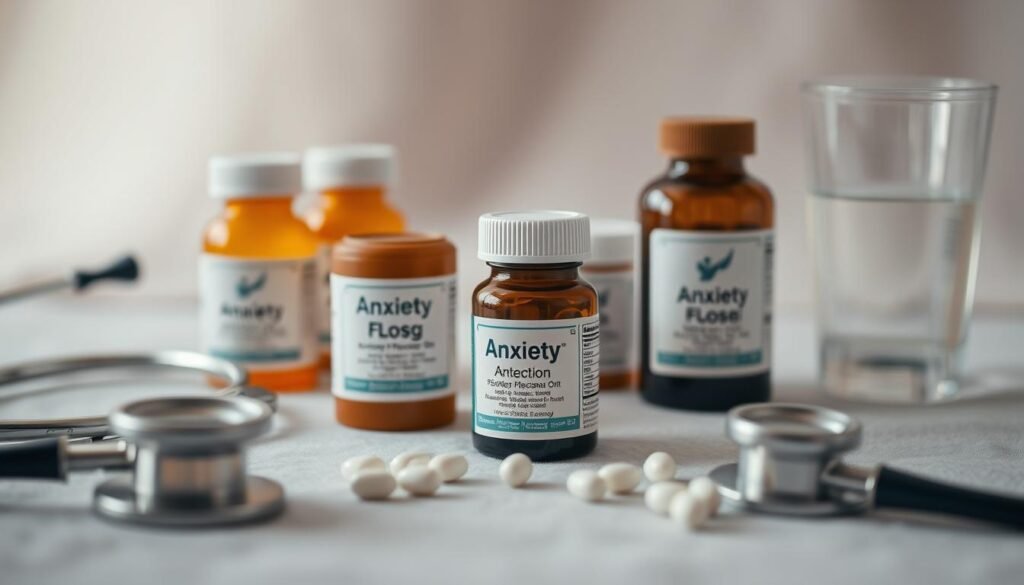Over 70% of people with anxiety feel breathless at times. This fact shows a close link between anxiety and trouble breathing. Understanding when to get help for breathing issues linked to anxiety is important. With more people dealing with anxiety in the U.S., it’s key to know how it can affect us physically.
Feeling short of breath can make someone think they’re in a health crisis. This can make their mental health worse. Learning about these moments can help people know when to seek care for their health and well-being.
Key Takeaways
- Anxiety often produces physical symptoms, including shortness of breath.
- Understanding when to seek help can significantly improve mental health outcomes.
- Shortness of breath can be mistaken for a medical emergency, leading to increased anxiety.
- Education on anxiety symptoms helps individuals manage their reactions better.
- Seeking professional help can open doors to effective treatments such as therapy and medication.
- Breathing exercises and relaxation techniques can alleviate symptoms.
- Awareness of the signs of anxiety-related breathing issues promotes better health decisions.
Understanding Anxiety and Breathing Issues
Anxiety can change how we breathe, often causing problems. When stressed, our bodies prepare for danger. This response makes adrenaline and cortisol levels go up. As a result, our heartbeat and breathing can change.
Many don’t see the link between their mental and physical health. Panic attacks can make someone feel out of breath or suffocated. These feelings can make anxiety feel even worse.
Common symptoms of anxiety-related breathing problems include:
- Shortness of breath
- Rapid breathing, often exceeding 14 breaths per minute in adults
- Tightness in the chest
- Dizziness or lightheadedness
- Feeling of suffocation
These symptoms show how closely our emotions are tied to how we breathe. Knowing this connection helps in managing anxiety better. By understanding the root causes, one can take steps to deal with anxiety.
It’s key to know that anxiety can show up as breathing troubles. Recognizing this early can help in finding treatment. Practicing certain breathing exercises can lower anxiety symptoms by up to 30%. This proves how crucial it is to understand the link between anxiety and breathing. Doing so can help people feel in control of their anxiety.
| Symptoms | Description |
|---|---|
| Shortness of Breath | A feeling of not getting enough air or difficulty in breathing. |
| Rapid Breathing | Breathing faster than the normal rate, often exceeding 14 breaths per minute. |
| Tightness in Chest | A sensation of pressure or constriction, leading to discomfort. |
| Dizziness | Feeling lightheaded or unsteady, sometimes accompanied by tingling sensations. |
| Feeling Suffocated | A distressing perception of not being able to breathe freely. |
Common Symptoms of Anxiety-Related Breathing Problems
Anxiety disorders show up in many ways, especially in how we breathe. Shortness of breath anxiety is common and scary. It can make you feel panicked. Many also feel tightness in their chest and breathe too fast, making them very uncomfortable.
Other anxiety symptoms linked to breathing issues include:
- Dizziness or lightheadedness
- Rapid heart rate or palpitations
- Feelings of suffocation or choking
- Tightness or pressure in the chest
- Nausea or gastrointestinal distress
Anxiety can greatly disrupt everyday life. Stress hormones make your heart race and muscles tense, changing how you breathe. This leads to worry, making breathlessness feel worse.
It’s key to understand these symptoms for better mental health. Knowing that shortness of breath anxiety is a part of anxiety guides people to the right help and support.
What Causes Shortness of Breath from Anxiety?
Shortness of breath from anxiety has to do with how our bodies handle stress. When we feel anxious, our fight-or-flight response turns on. This leads to a faster heart rate and breathing changes. Even if there’s no real danger, our body acts like there is, causing trouble breathing.
Several factors can make us feel breathless when we’re anxious. Issues with our heart or lungs are main examples. Asthma, COPD, and heart problems often lead to long-term breathlessness. Suddenly feeling short of breath could signal emergencies like allergic reactions or blood clots.
Panic attacks can make us breathe fast or hyperventilate. This makes our anxiety and breathlessness worse. Studies show that how we breathe can affect our anxiety. Things like our genes and hormones play a part too. It’s important to get the right help and treatments.
In conclusion, many health issues can cause breathlessness, from anxiety to lung conditions. Figuring out the cause helps people manage their anxiety. This makes dealing with breathing troubles easier.
| Cause | Type | Example Conditions |
|---|---|---|
| Anxiety Disorders | Psychological | Panic Disorder, Generalized Anxiety Disorder |
| Heart Conditions | Medical | Cardiomyopathy, Heart Failure |
| Lung Disorders | Medical | Asthma, COPD, Lung Cancer |
| Acute Medical Emergencies | Medical | COVID-19, Pneumonia, Anaphylaxis |
Anxiety Symptoms: The Connection to Breathing
Anxiety links closely with breathing troubles, leading to more stress. People with anxiety may feel like they can’t breathe well. This often starts with worry or stress. Suddenly, they might hyperventilate, feeling unable to breathe even though their lungs are fine.
When anxious, you might also experience a fast heartbeat, sweating, and chest tightness. These signs can make it hard to breathe, making anxiety worse. Recognizing these symptoms is key to finding help and using anxiety breathing techniques.
It is vital to understand that anxiety can cause shortness of breath. While other issues like medical conditions or allergies can do the same, it’s different for anxiety. Knowing this can help manage it better. Techniques like deep breaths and staying present can ease the effects.
Activities that relax you, such as meditation or being with friends, are helpful too. Seeing these symptoms as part of anxiety is important for dealing with it. Knowing the link helps you make good choices about getting help. This empowers you to control anxiety better.
Recognizing Anxiety Attacks and Breathing Difficulties
It’s key to know the signs of anxiety attacks and breathing problems to help early. Nearly 18% of Americans deal with anxiety disorder. These attacks can come on without warning and get bad fast, causing troubling symptoms. Knowing these signs lets people start managing their anxiety-related breathing issues sooner.
Signs of an anxiety attack include:
- Rapid breathing, which may feel like hyperventilation.
- Increased heart rate, often linked with feelings of panic.
- Restlessness, making it tough to stay still.
- An inability to focus on simple tasks.
- Sleep issues that can cause tiredness.
When these attacks happen, breathing patterns may change, making things worse. It’s crucial to understand the link between anxiety and breathing. This understanding is a big step in tackling breathing troubles caused by anxiety.
Recognizing these symptoms is vital for early help. Deep breathing exercises are useful, as they help manage breathing and lessen anxiety. You can try counting breaths or meditation anywhere to feel better quickly. Combining medication with cognitive behavioral therapy (CBT) is also a top way to treat these issues.
| Symptom | Description |
|---|---|
| Rapid Breathing | Often stems from high anxiety, leading to dizziness. |
| Increased Heart Rate | Typical in anxiety attacks, raising feelings of panic. |
| Restlessness | A need to move often, hard to sit still. |
| Concentration Issues | Struggling to think can affect daily chores. |
| Sleep Problems | Poor sleep can make anxiety symptoms worse, keeping the cycle going. |
By noticing the signs of anxiety attacks and breathing issues, people can tackle their mental health better. Raising awareness helps in taking an active stance towards finding relief and support.
Effective Anxiety Breathing Techniques
Dealing with anxiety’s breathing issues improves well-being significantly. There are many anxiety breathing techniques aimed at promoting relaxation and improving breath control. Using these techniques daily can help stop the rapid breathing seen in anxiety episodes.
Diaphragmatic breathing is a great method that reduces stress and helps control breathing. A study in Frontiers in Psychology shows it helps lessen stress effects. By breathing deeply, you breathe out longer, fighting the urge to panic that heightens anxiety.
Pursed lip breathing makes you exhale slowly and can improve heart health and reduce stress by managing airflow. Resonance breathing also offers stress and mood benefits, proven by Brigham Young University research.
The 4-7-8 breathing technique encourages calm by having you breathe in for four seconds, hold for seven, and breathe out for eight. While science is still catching up, people say it helps with anxiety and sleep. Regularly doing these breathing exercises can really help over time.
There are apps that help keep a regular breathing exercise routine. They send reminders and track your progress, helping you stick with it. Aim for practice sessions of five minutes or more for the best results.

| Breathing Technique | Benefits | Research Findings |
|---|---|---|
| Diaphragmatic Breathing | Reduces stress, improves breath control | Supported by Frontiers in Psychology |
| Pursed Lip Breathing | Enhances heart rate variability, eases tension | Promotes prolonged exhalation |
| Resonance Breathing | Modifies stress and mood responses | Validated by Brigham Young University |
| 4-7-8 Breathing Technique | Encourages relaxation and sleep improvement | Anecdotal effectiveness noted |
Regular practice can help you manage anxiety better. It’s a good idea to look for guidance from therapists or online, to get the most out of anxiety breathing techniques.
When to Seek Help for Anxiety-Related Breathing Problems
Knowing when to get help for anxiety breathing issues is key. Experiencing shortness of breath because of anxiety can be scary. It’s important to see a healthcare provider if these symptoms are bad, keep happening, or if you also feel chest pain or dizziness.
Anxiety can cause bodily reactions that make it hard to breathe. As this article shows, it’s important to understand how anxiety and physical symptoms are linked. Understanding this can help people find the right help.
It’s vital to know the seriousness of anxiety-related breathing problems. Getting help early can stop worse problems and improve outcomes. Talk to a doctor about getting worse breathlessness, especially if you have other health issues.
Evaluating anxiety symptoms and how they affect your life is important. If you notice troubling patterns, seek a full evaluation. Knowing your symptoms and getting help can lead to effective management and a better life.
Self-Care for Managing Anxiety-Related Breathing Issues
Self-care is key in handling anxiety-related breathing issues. Regular exercise is great for reducing stress and boosting your mood. It helps release endorphins, fighting off anxiety. Learning diaphragmatic breathing lets you control your breathing, easing symptoms.
Keeping a thought log is helpful too. Write down your worries to spot trends and tackle emotions better. It increases self-understanding, helping you fight negative thoughts linked with anxiety.

Adding relaxation tactics to your day builds resistance to anxiety. Mindfulness and meditation lower stress and improve emotional stability. Spending 30 to 40 minutes on an anxiety self-help guide can be greatly rewarding.
Avoiding stressful activities is common for those struggling. Identifying and confronting these triggers helps in finding effective coping methods. Sharing your feelings with loved ones builds support, aiding your self-care journey.
Spotting physical signs, like chest tightness or quick breaths, lets you tackle anxiety actively. Seeking expert advice, as suggested in this self-help guide, offers customized strategies for better mental health.
When to Visit a Doctor for Shortness of Breath
Feeling short of breath can be scary. Knowing when to visit a doctor for shortness of breath is key. Every year, about 4 million people go to the emergency room for breathing problems in the U.S. It’s especially worrying if breathing trouble starts all of a sudden, along with other serious signs.
Other alarming symptoms include chest pain and hard breathing. Also, if your nails or lips turn a different color, see a doctor fast. Did you know? 13% of all calls to emergency medical services are because of breathing issues. This shows how critical these situations can be.
If you’re struggling to breathe severely, don’t wait. Call 911 or go to the emergency room immediately. Doctors might give you oxygen through tubes or masks to help. Many conditions can cause breathing problems, like asthma, COPD, pneumonia, and pulmonary embolism. Each one needs its own treatment approach.
Here are more serious signs that mean you should see a doctor:
| Symptom | Emergency Action |
|---|---|
| Sudden and severe difficulty breathing | Call 911 immediately |
| Chest pain lasting more than a few minutes | Seek emergency care |
| Dizziness, fainting, nausea, or vomiting | Get checked by a doctor |
| Chest tightness or pain with cough | Visit the ER |
Sometimes, breathlessness happens for no clear reason. It could be unrelated to exercise. If so, a doctor’s assessment is needed fast. Anxiety can make breathing harder, but ongoing trouble breathing should be checked. It could signal something serious. For tips on handling these symptoms, check this resource.
The Role of Medication in Treating Anxiety and Breathing Problems
Medications are key in managing anxiety symptoms. They can also help with breathing issues. This allows people to handle their symptoms better.
Antidepressants like SSRIs and SNRIs are common options. It takes about 4 to 8 weeks for them to work well. Esketamine can offer faster relief, improving depression symptoms quickly. It is often paired with another antidepressant.
Mixing these antidepressants with certain meds can lead to serotonin syndrome. But, this is rare. Young people especially need careful watching. They may have more suicidal thoughts early in their treatment.
Benzodiazepines are good for quick help but should be used with care. They can lead to dependence. Long-term use might cause confusion and issues with breathing.
Buspirone needs time to work, usually weeks. It’s a safer option for the long haul, avoiding the addiction concerns of benzodiazepines. Atypical antipsychotics are another path. They can start to help in days, but getting the full effect might take longer.
Older adults should be cautious with these meds. Antipsychotics have risks for them, including a higher chance of stroke. Talking to a doctor about all your meds can help avoid harmful mixes.
| Medication Type | Time to Effectiveness | Considerations |
|---|---|---|
| SSRIs/SNRIs | 4-8 weeks | Monitor for suicidal thoughts |
| Esketamine | Hours | Used with oral antidepressants |
| Benzodiazepines | Immediate | Short-term use recommended |
| Buspirone | 3-4 weeks | Daily dosage needed |
| Atypical Antipsychotics | Days to 6 weeks | Monitor for side effects in older adults |

Therapeutic Approaches: Psychotherapy and Breathing Exercises
When dealing with anxiety and related breathing issues, it helps a lot to mix psychotherapy with anxiety breathing techniques. Cognitive Behavioral Therapy (CBT) is especially good for this. People can get better after just 8 to 10 sessions. CBT changes bad thought patterns and includes breathing exercises for quick symptom relief.
CBT for anxiety has an important step called thought challenging. It has three steps: find negative thoughts, question them, and think of something more realistic. Another part, exposure therapy, slowly makes you face your fears to lessen your anxiety. Sometimes, it’s part of CBT and uses specific ways to overcome fears.
Breathing exercises are also key in handling anxiety. Techniques like Belly Breathing, Box Breathing, Hand Breathing, and Pizza Breathing are recommended by experts such as Dr. Karin Ryan. They’re great for anxiety because they help you get more oxygen and get rid of waste gases, improving how your lungs work when you’re anxious.
The table below outlines the benefits of various deep breathing techniques:
| Breathing Technique | Benefits |
|---|---|
| Belly Breathing | Enhances relaxation by promoting full oxygen exchange, reducing overall tension. |
| Box Breathing | Improves concentration and performance while reducing stress through structured inhalation. |
| Hand Breathing | Provides a visual aid for breath control, helping to focus and calm the mind. |
| Pizza Breathing | Encourages mindfulness by engaging the imagination, making breathing exercises more enjoyable. |
Merging psychotherapy with specific breathing exercises is very helpful for those fighting anxiety and its breathing problems. Doing these anxiety breathing techniques regularly, with a professional’s help, boosts both mental and physical health. It makes you feel better overall. For more tips on anxiety breathing techniques, take a look at this resource.
Conclusion
Knowing when to tackle anxiety-related breathing issues is key for good health. About 21.3% of adults in the U.S. battle anxiety each year. It’s vital to know when to get help for these breathing problems.
Unfortunately, only 21.7% of those diagnosed seek treatment within a year. This shows how crucial it is to be active in dealing with anxiety and its effects.
Regularly using anxiety-management methods can really improve life quality. Techniques like cognitive-behavioral therapy and breathing exercises are helpful. They teach us how our bodies react to stress, turning fear into awareness.
Getting support from medical experts is essential while dealing with anxiety. Their guidance helps build resilience and deepens our understanding of anxiety.
Getting help early when symptoms show can stop them from getting worse. By facing anxiety-related breathing problems head-on, people can better manage their mental health. This way, they can enjoy a more fulfilling and joyful life.